You have sex, and then you get pregnant — or so your sex education classes would have you believe. But what happens in between?
-
Tracking cycle
-
Getting pregnant
-
Pregnancy
-
Help Center
-
Flo for Partners
-
Anonymous Mode
-
Flo app reviews
-
Flo Premium New
-
Secret Chats New
-
Symptom Checker New
-
Your cycle
-
Health 360°
-
Getting pregnant
-
Pregnancy
-
Being a mom
-
LGBTQ+
-
Quizzes
-
Ovulation calculator
-
hCG calculator
-
Pregnancy test calculator
-
Menstrual cycle calculator
-
Period calculator
-
Implantation calculator
-
Pregnancy weeks to months calculator
-
Pregnancy due date calculator
-
IVF and FET due date calculator
-
Due date calculator by ultrasound
-
Medical Affairs
-
Science & Research
-
Pass It On Project New
-
Privacy Portal
-
Press Center
-
Flo Accuracy
-
Careers
-
Contact Us
How long does it take to get pregnant after sex? A timeline
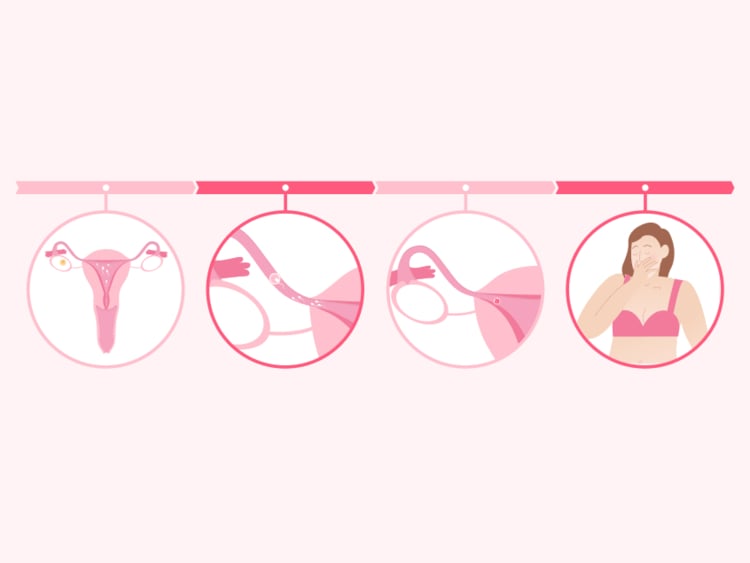

Every piece of content at Flo Health adheres to the highest editorial standards for language, style, and medical accuracy. To learn what we do to deliver the best health and lifestyle insights to you, check out our content review principles.
When you’re actively trying to get pregnant, it’s easy to get caught up with wanting to understand all the details about how it works. Sure, you might have attended sex ed classes at school like everyone else, but lots of us just learned how not to get pregnant — not so useful now!
You could be facing the prospect of using your body in a whole new way, which is probably why you’re googling things like “How long does it take to get pregnant after sex?” Trying to conceive can bring a newfound curiosity about your reproductive system, and the more you know, the more power you have.
Here at Flo, we’ve got all the answers you need. This expert guide includes details on how you get pregnant, plus a timeline of how long it takes after sex and when pregnancy symptoms might occur, so you can understand better what happens and when.
When can you get pregnant after sex?
You might assume that after having unprotected sex, pregnancy happens immediately. But, as this timeline of conception will show, that’s not the case. There are lots of stages that need to take place for an embryo (which later becomes a fetus) to be created, meaning pregnancy doesn’t physically begin until some days after sexual intercourse. However, when dating a pregnancy (known as gestational age), the first day of your last menstrual period is considered the starting point. This means that, often, when people discover they’re pregnant after missing a period, they’ll technically be four weeks pregnant (or more).

In order to understand the ins and outs of how long it takes to conceive after sex, let’s go back to basics. There’s only a certain time (known as the fertile window) in your cycle during which you even have a reasonable chance of getting pregnant if you have unprotected sex: on the day you ovulate, one day after ovulation, or the 5 days beforehand.
Ovulation is when an egg is released from your ovaries into your uterine tubes (also known as fallopian tubes). The egg only stays there for up to 24 hours before it disintegrates, but if it’s fertilized during its short lifespan by sperm, which need to swim competitively to get there, then pregnancy can occur.
Sometimes, if you’ve had sex in the few days before ovulation, you can still become pregnant. This is because sperm cells can live inside a reproductive tract for up to five days; they’ll wait there, and if an egg is released, there’s a chance one could fertilize it.
But don’t be fooled into thinking unprotected sex during your fertile window will lead to a pregnancy every time. On average, it’s believed healthy couples of childbearing age have around a 20% chance of conceiving in any given month. Forty-five percent of couples get pregnant within 3 months of trying, 65% of couples tend to get pregnant within 6 months, and 85% conceive within a year — so don’t lose hope if it doesn’t happen right away.
A timeline of how long it takes to conceive after sex
Now that we know roughly when in your menstrual cycle it’s possible to conceive a baby (you can predict your fertile window using our ovulation calculator), let’s get into the details of what exactly goes on after you have unprotected sex. We asked Dr. Jane Van Dis, assistant professor of obstetrics and gynecology at the University of Rochester, New York, US, to break it down for us.
Take a quiz
Find out what you can do with our Health Assistant
Between 15 and 45 minutes after sex: The sperm travels
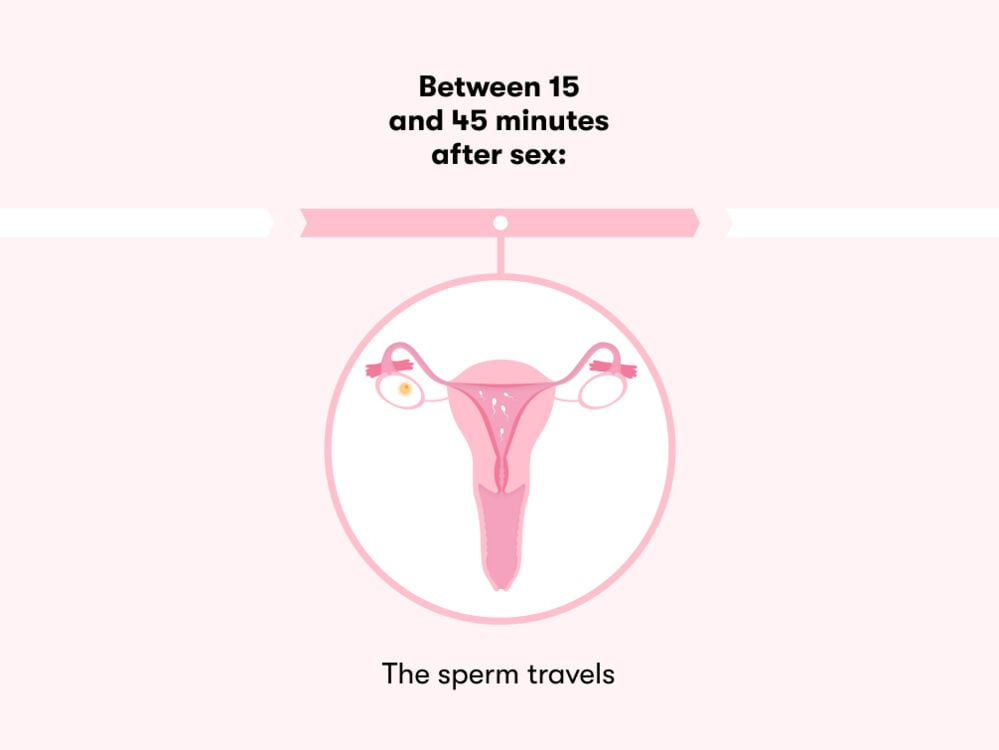
The first thing that needs to happen in order for a pregnancy to occur following unprotected sex is for sperm to travel through the vagina, the cervix, and then into the correct uterine tube where the egg is located on ovulation day. All in all, this is a distance of somewhere between 15 and 18 cm, and it’s believed to take around 15 to 45 minutes. During this journey, hundreds of millions of sperm cells drop off and don’t make it. It’s estimated that around 300 million sperm are typically released during sex, but only about 200 sperm ever actually reach the egg.
Between 45 minutes and 5 days after sex: Fertilization
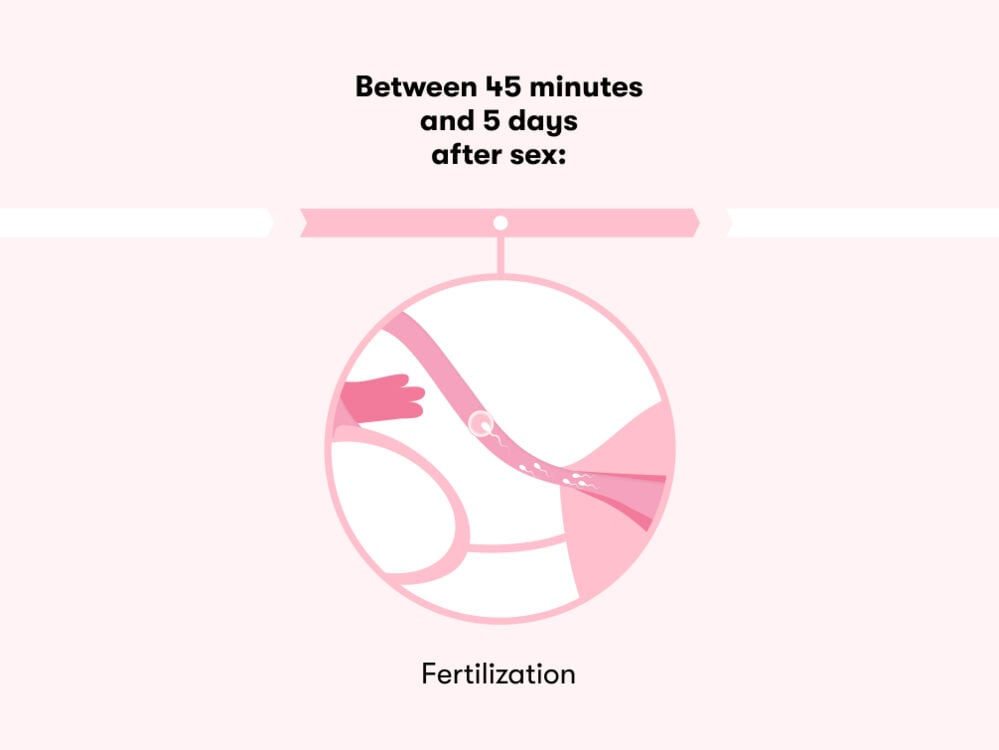
As we know, when sperm reach the uterine tubes, there isn’t always an egg there. In that case, sperm can wait inside the reproductive tract for up to 5 days until an egg is released, at which point, one may fertilize the new egg. Dr. Van Dis explains that fertilization is “the process by which sperm penetrates the egg wall.” This creates a fertilized egg, or what’s known scientifically as a zygote, which is what goes on to become the embryo.
Only one sperm can fertilize an egg, thanks to a clever mechanism; the egg’s external shell hardens immediately when the first sperm breaks through, ensuring no others can gain entry.
Between 6 and 10 days after conception: Implantation
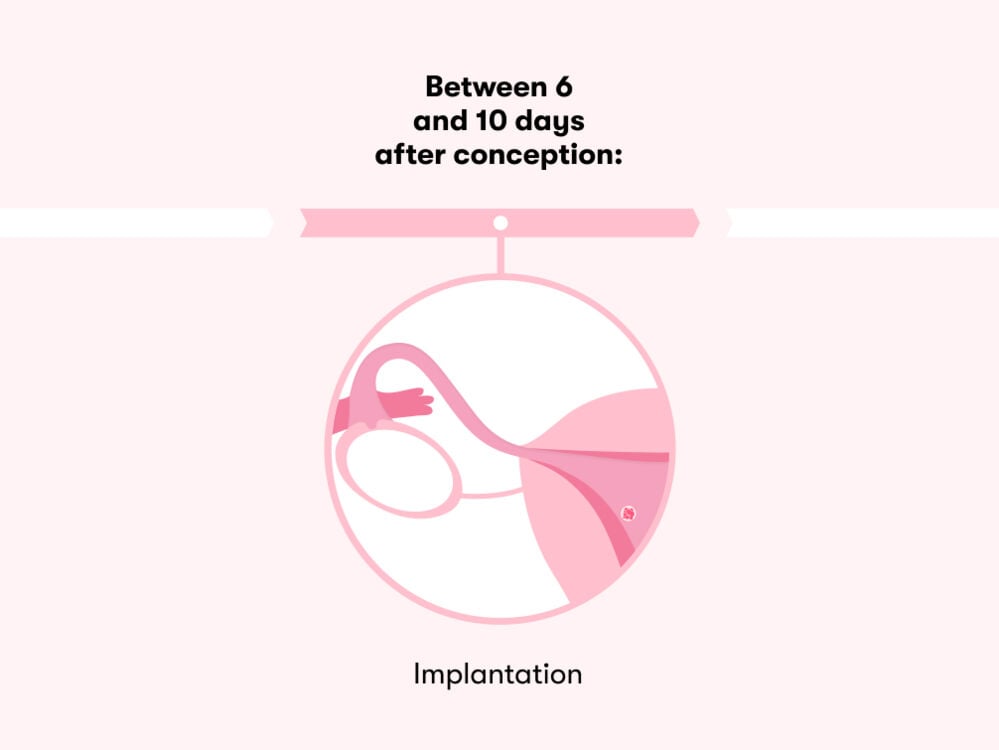
The next stage in the development of pregnancy is implantation, but how long after sex does implantation occur?
Once sperm penetrates and fertilizes the egg, the fertilized egg starts rapidly dividing until it becomes a cluster of cells that will later become an embryo. As the cluster grows, it begins to make a journey of its own, traveling from the uterine tubes to the uterus, where implantation can take place. This is when a fertilized egg implants (or attaches itself) to the uterine lining, and it happens around 6 to 10 days after conception.
In around a quarter of pregnancies, there may be some light spotting between 10 and 14 days after conception. This is known as “implantation bleeding,” and, confusingly, it usually happens at the time you would expect your next period. That can make it tricky to detect, but it tends to be lighter than your usual menstrual period. If you experience light spotting or other bleeding that doesn’t seem like your period, and you think there’s a chance you could be pregnant, it’s worth taking a pregnancy test or speaking to a health care professional.
Between 2 and 4 weeks after sex: Early pregnancy symptoms
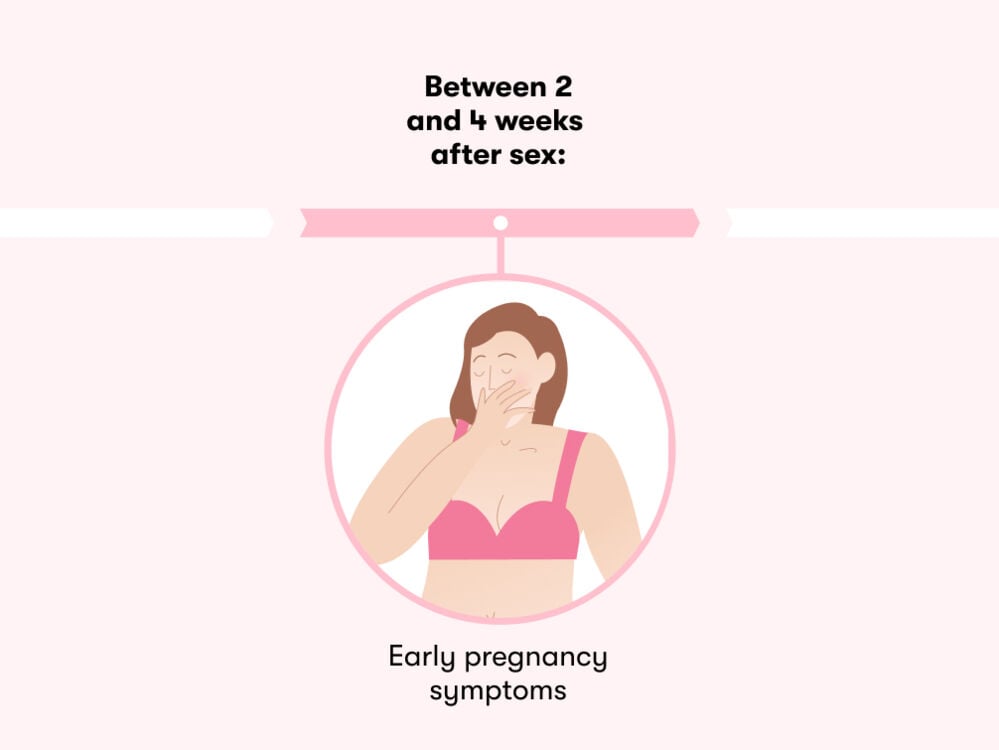
Everyone experiences pregnancy differently, which is why you might start noticing early pregnancy symptoms anywhere between 2 and 4 weeks after conception. “The most common sign of pregnancy is a missed period,” explains Dr. Van Dis. “Other common signs are fatigue, tender breasts, more frequent urination, and bloating.”
Some of the most typical signs of pregnancy are nausea and vomiting, with more than 94% of women experiencing them, according to a 2020 University of Warwick study. The severity of nausea varies from person to person, as does its duration. For most people, it goes away by 14 weeks of pregnancy, but for others, it can continue for longer. If you feel like nausea during your pregnancy is affecting your life, it’s best to speak to a health care professional.
Emotions can also fluctuate in the stages of early pregnancy and beyond. The flood of hormones can make you feel happy one minute and tearful the next. You may also have a sore back or experience headaches, food cravings, or food aversions. The area around your nipples (the areolas) may also become darker during early pregnancy — lots of changes!
How long after sex should you take a pregnancy test?
“The great news is that pregnancy tests have gotten better and better at detecting earlier pregnancies,” says Dr. Van Dis. The not-so-good news is that it still takes around 15 days after sex for a test to become positive.
So while you might feel anxious or excited for a couple of weeks after you think you ovulated, it’s worth holding out until at least the first day of your missed period to take an at-home pregnancy test to make sure you get a clear result.
At-home urine pregnancy tests are designed to trace the pregnancy hormone human chorionic gonadotropin (hCG), which your pregnant body starts producing around 10 days after fertilization and slowly increases as the fertilized egg becomes an embryo. By the time you notice you’ve missed a period, if a pregnancy has occurred, then hCG levels should be high enough at this point to yield a positive result.
When to take emergency contraception to prevent pregnancy after unprotected sex
It’s not just useful to understand the timeline of how long it takes to get pregnant after sex when you’re actively trying to conceive. It’s also very helpful if you want to prevent pregnancy but have had sex without birth control because then you know when you should take emergency contraception.
There are two different forms of emergency contraception: pills and an IUD:
- Copper IUD
Copper IUDs can be used as emergency contraception, and they’re the most reliable method, being almost 100% effective at preventing pregnancies if they’re inserted within 5 days of having unprotected sex.
- Pills
Alternatively, there are two types of emergency birth control pills you can take (also known as the morning-after pill). One is a progestin-only pill, which is thought to work by stopping or delaying the release of an egg. This must be taken within 3 days of sex to prevent pregnancy — but the sooner you take it, the better.
The other type of birth control pill contains something called ulipristal acetate, which avoids pregnancy by stopping the hormone progesterone from working normally. This also prevents ovulation, and it can be taken up to 5 days after sex. Similarly, though, the earlier you take it, the better the chance of avoiding an unwanted pregnancy.
If you require emergency contraception in any form, make sure you seek professional medical advice first so you’re sure you’re using the correct method and there aren’t any other considerations you should be aware of.
How long it takes to get pregnant after sex: The takeaway
Now that you have a better idea of how long pregnancy takes to come about, it’s important to remember that the specific timeline differs slightly for everyone. “None of this is a perfect science,” notes Dr. Van Dis. While some people may find out that a pregnancy has occurred around 15 days after sex, others may need to wait longer — and that’s normal.
And don’t forget that it may take some people longer to conceive than others, which is also to be expected. There are various factors that can influence if and when pregnancy might occur, including how regular your cycle is, your partner’s sperm count, and when you last ovulated.
Tracking your period regularly with an app like Flo can be a helpful way to understand more about sexual health and your own menstrual cycle — an important tool whether you’re trying to conceive or prevent an unplanned pregnancy.


Hey, I'm Anique
I started using Flo app to track my period and ovulation because we wanted to have a baby.


The Flo app helped me learn about my body and spot ovulation signs during our conception journey.


I vividly
remember the day
that we switched
Flo into
Pregnancy Mode — it was
such a special
moment.
Real stories, real results
Learn how the Flo app became an amazing cheerleader for us on our conception journey.
References
Alberts, Bruce, et al. Fertilization. Garland Science, 2002.
“Conception: How It Works.” Center for Reproductive Health, crh.ucsf.edu/fertility/conception. Accessed 23 Feb. 2023.
“Doing a Pregnancy Test.” NHS, www.nhs.uk/pregnancy/trying-for-a-baby/doing-a-pregnancy-test/. Accessed 16 Feb. 2023.
“Emergency Contraception.” The American College of Obstetricians and Gynecologists, www.acog.org/clinical/clinical-guidance/practice-bulletin/articles/2015/09/emergency-contraception. Accessed 16 Feb. 2023.
“Emergency Contraception (Morning After Pill, IUD).” NHS, 23 Nov. 2022, www.nhs.uk/conditions/contraception/emergency-contraception/.
“Fertilization and Implantation.” Mayo Clinic, 15 Nov. 2021, www.mayoclinic.org/healthy-lifestyle/pregnancy-week-by-week/multimedia/fertilization-and-implantation/img-20008656.
“Fetal Development: Month-By-Month Stages of Pregnancy.” Cleveland Clinic, my.clevelandclinic.org/health/articles/7247-fetal-development-stages-of-growth. Accessed 16 Feb. 2023.
“Fetal Development: The 1st Trimester” Mayo Clinic, 17 Sep. 2021, www.mayoclinic.org/healthy-lifestyle/pregnancy-week-by-week/in-depth/prenatal-care/art-20045302.
Gadsby, Roger, et al. “Nausea and Vomiting in Pregnancy Is Not Just ‘Morning Sickness’: Data from a Prospective Cohort Study in the UK.” The British Journal of General Practice: The Journal of the Royal College of General Practitioners, vol. 70, no. 697, Aug. 2020, pp. e534–39.
Gould, J. E., et al. “Assessment of Human Sperm Function after Recovery from the Female Reproductive Tract.” Biology of Reproduction, vol. 31, no. 5, Dec. 1984, pp. 888–94.
“Implantation Bleeding.” Cleveland Clinic, my.clevelandclinic.org/health/symptoms/24536-implantation-bleeding. Accessed 20 Feb. 2023.
“Implantation Bleeding: Normal in Early Pregnancy?” Mayo Clinic, 9 May 2019, www.mayoclinic.org/healthy-lifestyle/pregnancy-week-by-week/expert-answers/implantation-bleeding/faq-20058257.
Massinde, Anthony, et al. “Extensive Hyperpigmentation during Pregnancy: A Case Report.” Journal of Medical Case Reports, vol. 5, Sep. 2011, p. 464.
“Morning Sickness: Nausea and Vomiting of Pregnancy.” The American College of Obstetricians and Gynecologists, www.acog.org/womens-health/faqs/morning-sickness-nausea-and-vomiting-of-pregnancy. Accessed 24 Feb. 2023.
“Overview of Infertility.” MSD Manual Consumer Version, www.msdmanuals.com/home/women-s-health-issues/infertility/overview-of-infertility. Accessed 24 Feb. 2023.
“Ovulation Signs: When Is Conception Most Likely?” Mayo Clinic, 7 Dec. 2021, www.mayoclinic.org/healthy-lifestyle/getting-pregnant/expert-answers/ovulation-signs/faq-20058000.
“Session 24: Ovulation and Fecundity.” Human Reproduction, vol. 25, suppl. 1, June 2010, pp. I37–38.
Settlage, D. S., et al. “Sperm Transport from the External Cervical Os to the Fallopian Tubes in Women: A Time and Quantitation Study.” Fertility and Sterility, vol. 24, no. 9, Sep. 1973, pp. 655–61.
“Signs of Pregnancy/The Pregnancy Test.” Stanford Children’s Health, www.stanfordchildrens.org/en/topic/default?id=signs-of-pregnancythe-pregnancy-test-85-P01236&sid=. Accessed 24 Feb. 2023.
Su, Hsiu-Wei, et al. “Detection of Ovulation, a Review of Currently Available Methods.” Bioengineering & Translational Medicine, vol. 2, no. 3, 2017, pp. 238–46, doi.org/10.1002/btm2.
Su, Ren-Wei, and Asgerally T. Fazleabas. “Implantation and Establishment of Pregnancy in Human and Nonhuman Primates.” Advances in Anatomy, Embryology, and Cell Biology, vol. 216, 2015, pp. 189–213.
“Symptoms of Pregnancy: What Happens First.” Mayo Clinic, 3 Dec. 2021, www.mayoclinic.org/healthy-lifestyle/getting-pregnant/in-depth/symptoms-of-pregnancy/art-20043853.
History of updates
Current version (09 March 2023)
Published (06 June 2022)
In this article

Get your personal guide to fertility
-
Learn how to read your body's ovulation signals
-
Find daily conception tips from our experts
-
Chat with others who are trying to get pregnant




